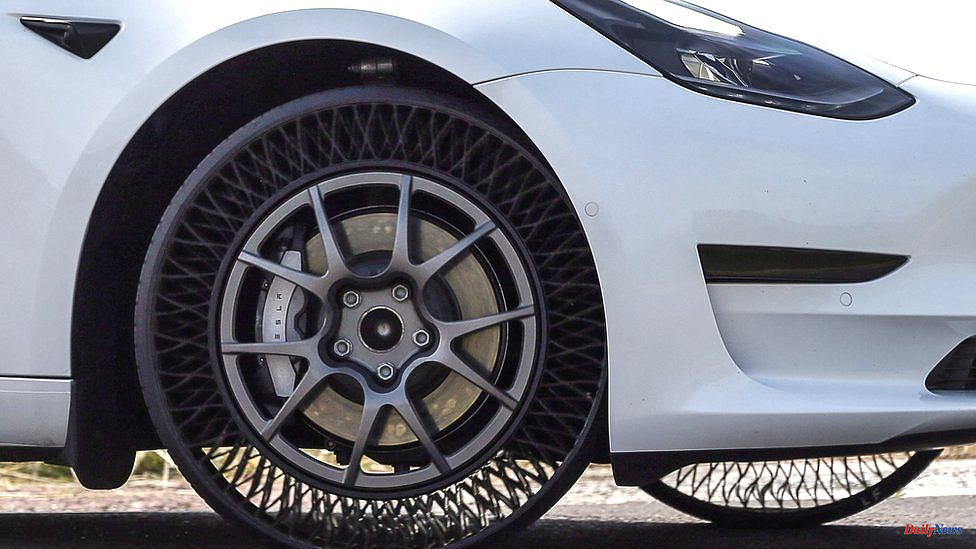It is still quite common to see a car dragging along on a flat tyre or having to change its wheels at the side of the road.
It is also expensive to replace tyres that are prematurely worn, possibly because the driver hasn't been checking their pressure as often as they should.
It can be difficult to not feel that tyres are the weak link in a car's overall structure. Is this changing?
It is the end of the black rubber-filled doughnut made from air and used on cars in 1890s. This product was designed to be indestructible and not easily recyclable.
A Tesla Model 3 twists through tight corners and makes emergency stops on a Luxembourg track. Standard stuff. The most remarkable thing about this car is its four-wheel suspension. They are made by Goodyear, a US manufacturer.
Specially made plastic spokes support a rubber tread that is thin and reinforced. As the car moves, the spokes bend and contract.
Michael Rachita is Goodyear's senior program manger for non-pneumatic tires (NPTs). He says there will be some noise and vibration. We are still learning how we can soften the ride. We think you will be amazed at the results. He was right.
The tyre market is changing with autonomous and electric cars. Transport companies and shuttle services need products that can be recycled, are puncture-proof, low-maintenance and that can map the road conditions.
Ride hailing and car sharing are becoming more popular in cities than owning a car. A car that has a flat tire is not making money.
Mr Rachita states that while air-filled tires will always be in use, there are many other options. As we move into a world where autonomous vehicles are becoming more common and many cities are offering transport-as-a-service strategies, having a maintenance-free tyre is hugely important."
Goodyear's laboratories test the tyres for 24 hours under various loads and speeds. This is thousands of miles per hour. Mr Rachita states that while some spokes may deform or break, the structures still perform safely. He says, "It's all about test-learn," But we are at a point that has given us a lot of confidence. This is the real deal.
Michelin, a Goodyear competitor, has been working with General Motors on airless tyres ever since 2019. According to media reports, Michelin's Unique Punctureproof Tire System (Uptis), could be used on a new Chevrolet Bolt Electric Car being developed by GM in February.
Uptis tyres use high-strength resin with composite rubber and fiberglass (Michelin has filed 50 patents for this combination) to create a mesh structure around an aluminum wheel.
Cyrille Roget is a French tyre manufacturer's innovation and scientific expert. However, she won't confirm Bolt's reports but told the BBC Michelin that they will have more to share later in the year.
Michelin is a market leader for airless wheels. The Tweel (tyre wheel) is a product of Michelin that has been in existence since 2005. It can be used on slow-moving equipment, such as farm machinery.
However, optimising technology for road vehicles presents a completely different challenge. Mr Roget states that he has 130 years of experience in designing inflatable structures such as pneumatic tyres. The airless technology is relatively new.
Uptis is only a first step towards something greater. The multi-year plan of the company behind the Michelin Man logo is to develop a tyre which is connected, airless, and 3D-printed from materials that can be melted and reused.
According to Michelin, the only maintenance required is occasional re-treads.
Airless structures that are heavy in battery weight make them ideal for electric vehicles. Rachita states that you can carry more weight with a more flexible feel than an air tyre.
Airless tyres, on the other hand, have a larger contact area with the road which increases drag. This rolling resistance requires more energy to propel the tyres forward, which can have negative effects on battery life and range.
Then there is the noise of rubber-on road.
Matt Ross, editor in chief of Tire Technology International, says that "engine sound is removed from an electric car so tyres become a dominant source of noise."
The suspension transmits vibrations through suspensions that are more rigid due to the presence of plastic spokes. He feels that drivers who have been used to the performance and response of air tyres may need some convincing.
Regulators' decisions are more important than consumers' perceptions.
The government will require stringent safety testing and standardization of rules. Tyre manufacturers will have to invest heavily in new manufacturing plants and develop supply chain infrastructures. It will take many years.
Tyre manufacturers hope that early adopters will be able to drive the technology forward in niche markets. Klaus Kraus, Hankook's head of European research, says that non-pneumatic tires (NPTs), are particularly attractive to certain sectors such as the military, disaster response vehicles and specialist machinery.
In January, the South Korean company revealed the latest version its iFlex NPT. The company claims that the honeycomb of interlocking polyurethane spokes made from polyurethane is smaller than conventional tyres and can withstand both horizontal and lateral stresses.
Technology for business:
Bridgestone, the largest tyre manufacturer in the world, is interested in industrial applications for farming, mining, and construction. Customers who see a loss in productivity due to tyre failures could have high demand.
At first, airless tires will be more expensive than regular tyres. However, the possibility of regular re-treading or 3D printing could make a difference. Experts speculate that consumers may not even have to purchase tyres. They'll instead get them for free, pay-per-mile and with sensors that monitor usage.
This is a great example of how technology is going to transform the tyre of tomorrow, according to Sosia Causeret, analyst at Goodyear's Sightline Tyre Intelligence division. Tyres are the only link between vehicle and road, offering huge potential.
Perhaps connected vehicles can provide information to the government about road conditions and grit for freezing weather, using cloud computing and algorithms.
Automatic braking systems are another example. "If the vehicle's summer tyres are half-worn, the ABS can detect this and react faster. She says this advantage could be a significant factor in autonomous futures where the vehicle must react on its own.
This tech does not have to be limited to airless tires. NPTs may not be the future for all manufacturers. According to Denise Sperl (Director of Car Tyre Research and Development at Continental Germany), pneumatic tyres remain the best option for most vehicles.
She says that tyres will always have to meet "multiple requirements for safety, comfort and sustainability". Air-filled rubber is the best compromise.
Continental is working on a self-inflating system that uses sensors and pumps in the wheel to maintain the right pressure.
The company, like all manufacturers, is interested in "greener" products. The company will soon use polyester from recycled plastic bottles in premium tyres. Goodyear and Continental are also researching a dandelion plant that produces latex similar with rubber trees.
Ms Sperl says that sustainable alternatives to traditional materials are not available "to a limited degree". Air tyres are the best for their job, which is why they have been around for so long. She says, "We are still convinced of this."












